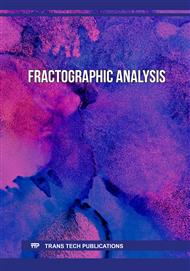[1]
T. O. Mbuya, Influence of iron on castability and properties of aluminium silicon alloys. Int. J. Cast Met. 16 (2003) 451-465.
DOI: 10.1080/13640461.2003.11819622
Google Scholar
[2]
M. Cagala, M. Bruška, P. Lichý, J. Beňo, N. Špirutová, Influence of aluminium-alloy remelting on the structure and mechanical properties, Mater. Technol. 47 (2013) 239-243.
DOI: 10.21062/ujep/x.2013/a/1213-2489/mt/13/1/31
Google Scholar
[3]
K. Al-Helal. J. Lazaro-Nebreda, J.B. Patel, G.M. Scamans, high-Shear de-Gassing and de-Ironing of an aluminum casting alloy made directly from aluminum end-of-life vehicle scrap, Recycling 6 (2021) 66.
DOI: 10.3390/recycling6040066
Google Scholar
[4]
L. Muchová, P. Eder, End-of-waste criteria for aluminum and aluminum alloy scrap, Technical Proposals (2010), EUR 24396 EN – 2010, ISSN 1018-5593.
Google Scholar
[5]
N. Y. Mansurov, A. R. Rikhsiboev, S. Y. Mansurov, Features of multicomponent secondary aluminum alloy structure formation, Metallurgist 63 (2020) 11-12.
DOI: 10.1007/s11015-020-00952-7
Google Scholar
[6]
J. Kasinska, D. Bolibruchová, M. Matejka, The Influence of Remelting on the Properties ofAlSi9Cu3 Alloy with Higher Iron Content, Materials 13 (2020) 575.
DOI: 10.3390/ma13030575
Google Scholar
[7]
Y. Zhao, D. Song, H. Wang, Y. Jia, B. Lin, Y. Tang, Y. Tang, D. Shu, Z. Sun, Y. Fu, W. Zhang, Revealing the Influence of Fe on Fe-rich Phases Formation and Mechanical Properties of Cast Al-Mg-Mn-Fe Alloys, Journal of Alloys and Compounds 901 (2021) 163666.
DOI: 10.1016/j.jallcom.2022.163666
Google Scholar
[8]
L. Kuchariková, D. Medvecká, E. Tillová, J. Belan, M. Kritikos, M. Chalupová, M. Uhríčik, The effect of the β-Al5FeSi phases on microstructure, mechanical, and fatigue properties in A356.0 cast alloys with higher Fe content without additional alloying of Mn. Materials 14 (8) (2021) 1943.
DOI: 10.3390/ma14081943
Google Scholar
[9]
D. Bolibruchová, L.Richtárech, Effect of adding iron to the AlSi7Mg0.3 (EN AC 42 100, A356) alloy, Manufacturing technology 13 (3) (2013) 276-281.
DOI: 10.21062/ujep/x.2013/a/1213-2489/mt/13/3/276
Google Scholar
[10]
W. S. Ebhota, T. C. Jen, Intermetallics formation and their effect on mechanical properties of Al-Si-X Alloys, Intermetallic compounds – formation and applications, 2018.
DOI: 10.5772/intechopen.73188
Google Scholar
[11]
Z. Ma, A.M. Samuel, H. W. Doty, F. H. Samuel, On the Fractography of Impact-Tested Samples of Al-Si Alloys for Automotive Alloys. Fracture mechanics – properties, patterns and behaviors, 2016.
DOI: 10.5772/63409
Google Scholar
[12]
T. O. Mbuya, Influence of iron on castability and properties of aluminium silicon alloys. Int. J. Cast Met. 16 (2003) 451-465.
DOI: 10.1080/13640461.2003.11819622
Google Scholar
[13]
L. Zhang, J. Gao, L. N. W. Damoah, D. G. Robertson, Removal of Iron From Aluminum: A Review, Mineral Processing and Extractive Metallurgy Review 33 (2) (2012) 99-157.
DOI: 10.1080/08827508.2010.542211
Google Scholar
[14]
J. Pezda, Optimization of Heat Treatment Parameters of AlSi7Mg Alloy. Materials 15 (2022) 1163.
DOI: 10.3390/ma15031163
Google Scholar
[15]
J. Sena, et al, Influence of chemical composition and impurities on microstructure and formation of intermetallic phases in selected aluminum alloys. Proceedings 29th International Conference on Metallurgy and Materials (2020) 1174-1180.
DOI: 10.37904/metal.2020.3622
Google Scholar



